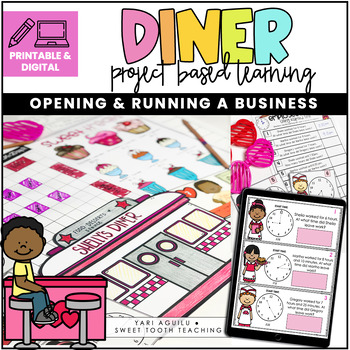Project Based Learning- Build & Run A Restaurant Diner + Distance Learning
- Zip
- Google Apps™

What educators are saying
Description
Your students have decided to open up their very own Restaurant Diner! They will use real-life math skills to plan, design, and manage their business.
This PBL (Project-Based Learning) project is perfect for late second graders, third graders or early fourth graders. It can be used as a part of your economics unit or as a review of math skills learned throughout the year. Your kiddos will need to apply the following math skills in order to successfully run their diner:
- Addition (Decimals & non-decimals)
- Subtraction
- Multiplication
- Rounding
- Measurement (Area)
- Data (Graphs & Tally Tables)
- Money
- Elapsed time
Throughout the course of the project, students will be challenged with:
- Planning and designing the diner layout
- Writing checks
- Hiring employees
- Calculating employee salaries & hours worked
- Advertising
- Calculating daily sales
- Adding customer totals & change
- Counting customer money
- Analyzing monthly sales & graphing data
Vocabulary cards & shoe box diorama model extension activity are also included.
*** NOW INCLUDES: Digital Version for Distance Learning (GOOGLE SLIDES)
Students simply type in their answers in the text boxes!
When you download the DIGITAL RESOURCE, you'll find:
- Teacher Directions- (extremely easy and requires no prep!)
- Step by Step instructions on how to download and make a copy of a Google Slide.
- Step by Step instructions on how to assign Google Slide assignments to your students.
- Step by Step instructions on how to assign on Google Classroom.
Engage your kiddos with real-world problems and challenges that are exciting and meaningful!
>>> Check out the "Pet Grooming PBL Project" HERE!
>>> Check out the "Camping PBL Project" HERE!
If you have any questions, please feel free to email me: SweetToothTeaching@gmail.com
-----------------------------------------------------------
Earning TPT Credits for Future Purchases:
After purchasing an item on TPT, go to the "My Purchases" page. Click the "Provide Feedback" button next to the item you have purchased. You will provide a quick rating and comment for the item. By providing feedback, you will gain TPT credits to use towards future purchases.
-----------------------------------------------------------





